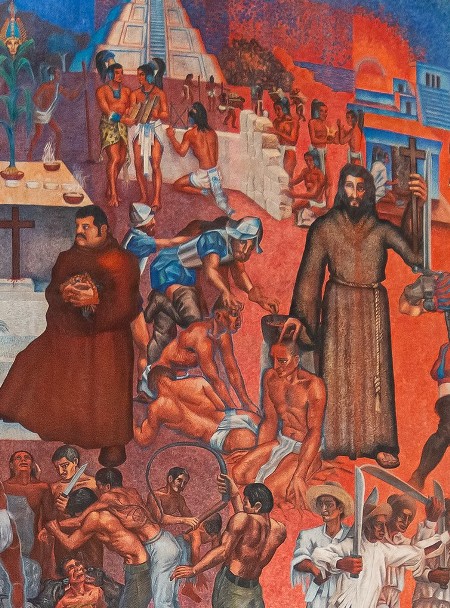Multiples adventures
Dominicans and Franciscans in Maya land - XVIth century
A trip by Las Casas to Tabasco and Chiapas
Pedro de Barrientos in Chiapa de Corzo
Las Casas against the conquistadores
Fuensalida and Orbita, explorers
Numerous studies
An ethnologist friar, Diego de Landa
Two teachers, Juan de Herrera and Juan de Coronel
Two historian friars, Cogolludo and Remesal
A multitude of buildings
A Franciscan turned architect: Friar Juan de Mérida
The Valladolid convent in the Yucatán
The Izamal convent and its miracles
In the Yucatán, a church in every village
A Dominican nurse, Matías de Paz
A difficult task: evangelization
The creation of the monastery of San Cristóbal
The Dominican province of Saint-Vincent
An authoritorian evangelization
Franciscans and the Maya religion
The failure of the Franciscans in Sacalum, the Yucatán
Domingo de Vico, Dominican martyr
The end of the adventure
Additional information
The Historia Eclesiástica Indiana of Mendieta
The road of Dominican evangelization in Guatemala
The convent of Ticul, as seen by John Lloyd Stephens
The Franciscans in the Colca valley in Peru
The convent route of the Yucatán in the XVIth century
The dominican mission of Copanaguastla, Chiapas
Available upon request: -
general information upon Maya countries, - numbered texts
on the conquest and colonization
of Maya countries
Address all correspondence to:
moines.mayas@free.fr
|
AN AUTHORITARIAN EVANGELIZATION
|
The mendicant orders, Franciscans and Dominicans, had come to Mexico with the intention of building the Kingdom of God on earth. Here in the New World, they thought, Christianity could be recut from the original template, with none of the failings it had suffered in the Old. Men with such a mentality were of course quite unmoved by pleas for religious tolerance. The friars drove the Mexican priests from their temples and began the first battle against the devil and the diabolical religions.
The ultimate mendicant objective was a separate Indian realm –a república de indios- organized along quasi-medieval corporatist lines, under theocratic rule sanctioned by the Crown, a realm from which Spaniards and Spanish ways would be paternalistically excluded. But it is certain, too, that mendicant rule displayed less benevolent features in practice. Corporal punishment was used to discipline the new Indian converts, and in Yucatán, Diego de Landa, provincial of the Franciscans, institute a reign of terror against Maya idolatrers in the 1560s.
Forced conversions. Chetumal, Mural in the Congres of Quintana Roo, author Elio Carmichael, "Forma, color e historia de Quintana Roo."
Here is described the Franciscan fight in Yucatán, according to the accounts of Diego López de Cogolludo:
The Franciscans deploy much zeal to convert the Mayan people
“The idea according to which our first founding fathers of this province (Yucatán) also organized the spiritual government of the Indians is widespread, and its implementation widespread as well; and the rest, all that contributes to their perfect Christianization and the good of their souls: I can confirm it since all those who have been to Yucatán witnessed it and are seeing it with their own eyes. With remarkable and commendable enthusiasm, these fathers go to each village to say mass on holy days when the Indians must attend, and they preach the gospel for the day each time, which is quite a burden, and they preach love of virtue and rejection of vices. It is no small job for the missionaries since four times as many priests would be needed with a faith as great as ours to ensure a permanent presence in all the villages; but the love they have for the Indians and their great enthusiasm for the two divinities, divine and human, make up for this shortcoming. This permanent presence of priests and religious men is found in places chosen as centers and convents, from where they depart, on the eve of holy days, to the villages they are responsible for: and most of the time, they must say mass in two villages, and sometimes in three: only by doing so is one capable to understand the amount of work it represents, because on top of it they administer in each village the sacraments of baptism, wedding ceremonies, penance, Eucharist and extreme-unction to those requesting them, carrying the most saintly vial to the homes of the sick with the requested decency and reverence.
A scene of pacific evangelization in John Phelan, The millennian kingdom of the Franciscans in the new world, University of California Press, 1970
They make Sunday mass compulsory
“Once mass is celebrated, the faithful are counted with the help of lists containing names of the Indians of the villages, according to the distribution I already described, and thanks to which the missionary knows those who came to church. This exercise takes place on the square in front of the churches, since twenty years ago there were so many inhabitants that it was necessary to be on the plaza of the village to count the people since the plaza was always next to the church : today half the inhabitants are gone and it is a shame to witness it. Each responsible person (called Chunthan –ah chun than-) must give the number of attendees for his district, and since we know them, we see them outside the church at their proper place, so that it is easy to find out who missed mass. The priest asks why mass was missed, and the person responsible gives a reason when it is legitimate, be it illness, a trip away from the village, or away to an unknown place (which happened often and is still why a great number of people are missing), but usually, the responsible person knows where to find the missing.”
Missing mass is severely punished
“But when someone does not attend for a valid reason, and when the responsible person does not support him, some mission assessors got get him; and if he does not give a valid reason once in the presence of his spiritual father, he is punished by the governor who attends the meeting, and who orders him to be whipped, and whipped for a longer period if he misses mass several times. When the absentees are not found on the spot, their names are written down and a small piece of string that is given after mass or on holy days to those who attend is kept, and the missionary, who is thus aware that the person was absent the previous time tells him of his sin, lectures him and urges him not to miss church and not to be a bad example for the others and give them the idea to do the same.”
(Diego López de Cogolludo, Historía de Yucatán, book 4, chapter 17, translated by Chantal Burns)
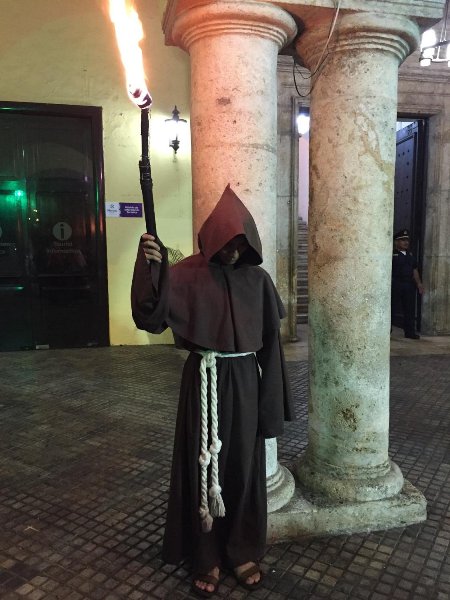
The auto-da-fé of Mani, performed in front of the cathedral of Mérida, as part of "Noche de Leyendas", a theatral walk trough the streets of the historic center of the city
An adulatory temple is discovered in Mani
“With the help of the priests whom Father Bienvenida had brought along and who had already learnt the language of the Indians, the best order had been given to evangelization: but at the time when the venerable provincial (Diego de Landa) assumed that idolatry had been forgotten thanks to his zeal and that of the other monks, they discovered that the devil was waging quite a war against them. Some Indians from the village of Mani were practicing idolatry, breaking the promise they had given when they were baptized, and even though this sin was practiced secretly, divine majesty allowed it to be uncovered, and a domino effect took place and other and unsuspected sins committed by other Indians in different places were found, so that these miserable and distraught souls were forgiven and those who did not practice idolatry were forewarned. There was in the convent of Mani an Indian by the name of Pedro Che, who was a doorman. One Sunday, he felt like leaving the village to hunt rabbits which are plenty in the region. He went out in the streets that looked more like forest paths than like village streets (since the Indians did not clear them as well as they do now) and small dogs walked alongside the Indian as they were attracted by the smell, and they went into a cave and came out dragging a small deer that had just been killed and whose heart had been torn out. The surprised Indian went into the place from where the dogs came, and guided by the smell of copal smoke (their incense), came inside the cave where there were an altar and well decorated tables with many idols that had been sprayed with the still fresh blood of the deer. Scared by what he saw and because he was a good Christian, he left the cave and quickly told Father Pedro de Ciudad-Rodrigo, his guardian, what he had seen. Father Rodrigo in turn told the provincial who was in Merida.”
Diego de Landa leads an investigation
“The zealous minister was saddened by this sin committed by sons whom he had led to Christ and who offended his name and his religion, and he himself decided to find a remedy to such great evil. As he mastered the language of these indigenous people, he quickly discovered who had succumbed to this sin, and using his apostolic authority, he officially investigated and proceeded to conduct a legal investigation against the adulatory Indians renegades of the faith, and he discovered at the same time other adulatory practices among the Indians living in the east of the region, the Cupúles, Cochuaxes de Zotuta, Canules and others. He noticed that many Indians who had secretly clung to their idolatry had been buried in a saintly place and he ordered them to be unearthed and to have their bones thrown into the woods.”
He organizes an auto-da-fé in Mani to punish the Indians
“Once he had solid proof, he decided to conduct a public auto-da-fé in the manner of the Inquisition in the village of Mani to scare the Indians, and in order to implement it he requested the Alcalde to provide a public force. Not only did he do it, but on the day chosen for this ceremony, he went to the village of Mani to attend it and took with him almost all of the Spanish nobles in the region, to give the required importance to the ceremony as well as to get protection in case of trouble. On that day, a multitude of Indians had gathered to watch something entirely new to them: during the ceremony, the sentences were read and the idolatrous people were punished with the help of the public force; nevertheless, some of them who were adoring the devil and did not repent had hung themselves for fear of punishment, because some of them, it seems, had already relapsed: their bodies were thrown into the woods. To get protection from idolatry, he gathered all the old books written in the Maya language that were available to the Indians, in order to prevent them from remembering their ancient rites : all that could be found on the subject was burnt publicly on the day of the auto-da-fé, and all traces of their past history were erased at the same time. Thanks to this action, no idolatry among the Indians was discovered or known during many years, although the rivals of the blessed Father described him as a cruel man. But Doctor D. Pedro Sanchez de Aguilar in his “Memoire against the adulatory people on this Earth” judged this event quite differently.”
(Diego López de Cogolludo, Historia de Yucatán, book 6, chapter 1, translated by Chantal Burns)

Mural by Miguel Tzab in the market Abelardo Rodríguez, in Mexico, 1934
Pedro Sánchez de Aguilar
“Towards the year 1550, some Indians of the province, although not all of them, turned away from the Faith and went back to being adulatory; Friar Diego de Landa, an apostolic saintly man, energetic in his actions and his words, was then Custodian of his order and had Episcopalian authority thanks to the OMNIMODA Bull of the Roman Pope Alexander VI and other briefs, in the absence of a Bishop in the diocese at that time: he rebelled against them, and carried away by divine zeal and acting like a new Mattathias (Maccabées II), he destroyed the altars of the idols, arrested those who adored them, had them whipped and thrown in jail; and he and his companions (whose names are consigned in the Book of Life) eradicated this sin as much as possible, through force and pressure, so much so that the Indians got frightened and remained so for many years, and not only did they give up idolatry but also the drinks (Balche) they drank during their binges.”
(Informe contra los adoradores de idolos del Obispado de Yucatán. Año de 1639. Pedro Sánchez de Aguilar)
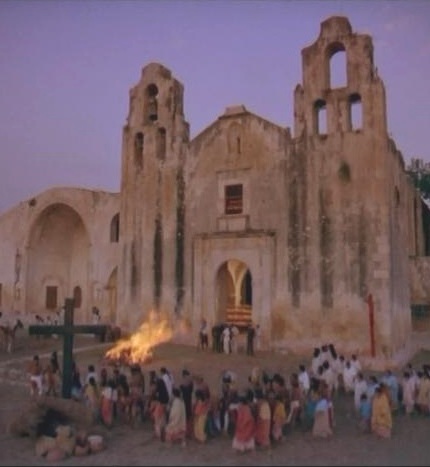
The auto-da-fé in Maní, reconstitution
Letter of Francisco de Montejo Xiu, Governor of Maní, and other prominent town governors, to the King, April 12, 1567.
"Sacred Catholic Majesty:
"After we learned the good, in knowing God our Lord as the only true god, leaving our blindness and idolatries, and your majesty as temporal lord, before we could well open our eyes to the one and the other, there came upon us a persecution of the worst that can be imagined; and it was in the year ’62, on the part of the Franciscan religious, who had taken us to teach the doctrine, instead of which they began to torment us, hanging us by the hands and whipping us cruelly, hanging weights of stone on our feet, torturing many of us on a windlass, giving the torture of the water, from which many died or were maimed.
"Being in these tribulations and burdens, trusting in your majesty's Justice to hear and defend us, there came the Dr. Quijada to aid our tormentors, saying that we were idolaters and sacrificers of men, and many other things against all truth, which we never committed during our time of blindness and infidelity. And as we see ourselves maimed by cruel tortures, many dead of them, robbed of our property, and yet more, seeing disinterred the bones of our baptised ones, who had died as Christians, we came to despair.
"Not content with this, the religious and thy royal Justice, held at Maní a solemn auto of inquisition, where they seized many statues, disinterred many dead and burned them there in public; made slaves of many to serve Spaniards for from eight to ten years, and placed the sambenitos. The one and the other gave us great wonder and fear, because we did not know what it all was, having been recently baptised, and not informed;. and when we returned to our people and told them to hear and guard justice, they seized us, put us in prison and chains, like slaves, in the monastery at Mérida, where many of us died; and they told us we would be burned, without our knowing the why. [...]
"One thing that has greatly dismayed and stirred us up, is the letters written by fray Diego de Landa, chief author of all these ills and burdens, saying that your majesty has approved the killings, robberies, tortures, slaveries and other cruelties inflicted on us; to which we wonder that such things should be said of so Catholic and upright a king as is your majesty. If it is told that we have sacrificed men after that we received baptism, it is a great and false witness invented by them to gild their cruelties. [...]
"The religious of San Francisco of this province have written certain letters to your majesty and to the general of the order, in praise of fray Diego de Landa and his other companions, who were those who tortured, killed and put us to scandal; and they gave certain letters written in the Castilian language to certain Indians of their familiars, and thus they signed them and sent them to your majesty. May your majesty understand that they are not ours, we who are chiefs of this land, and who did not have to write lies nor falsehoods nor contradictions. May fray Diego de Landa and his companions suffer the penance for the evils they have done to us, and may our descendants to the fourth generation be recompensed the great persecution that came on us.
"May God guard your majesty for many years in his sacred service and for our good and protection. From Yucatan, the 12 of April, 1567.
"Your majesty's humble vassals kiss your royal hands and feet."
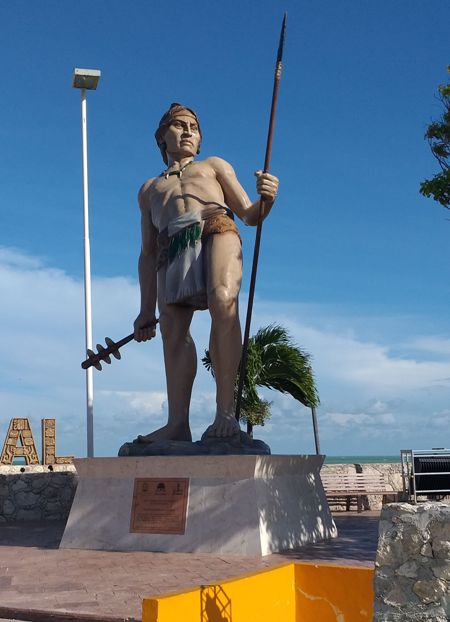
Statue of Nachi Cocom, lord of Sotuta, at Chetumal, Quintana Roo. Nachi Cocom was the last independant Maya king of the state of Sotuta in Yucatan. After the conquest, he befriended Diego de Landa and served as one of his informants on Maya culture.
Diego de Landa’s indictment of the Sotuta Indians, 11 August 1562
"In the village and advocacion St Peter, head village of this province of Sotuta, which is held in encomienda by Juan de Magaña, citizen of the city of Merida, the which said village is in the boundaries and jurisdiction of the said city, on the eleventh day of the month of August, the year of our Lord one thousand five hundred and sixty-two years, the very magnificent and reverend Lord Fray Diego de Landa, first Provincial of these provinces of the Order of the monasteries of the lord St Francis that are founded in this province, and Apostolic Judge of the Holy Office by bulls of His Holiness conceded and secured at the request of His Majesty,
"before me, Juan de Villagomez, his notary and apostolic notary in all the kingdoms and lordships of His Majesty through nomination by Luis Sanchez, Palatine Count, by bulls of His Holiness conceded to him in order to nominate notaries and other things:
"he said that in so far as His Grace being in this village and province punishing the idolatries which have been and are now in it, he has been informed and thus it is that among the chiefs and principales of the said village and province and the rest of the common people there have been great sacrifices and heresies within the churches, and not fearing the fear of God our Lord, holding as they have held for little the things of our Holy Catholic Faith, they have gone against it preaching within the churches the false sect of the devil and things of idolatries as they were used and accustomed to do in the time of their heathen past, bringing to the church for the said preaching the idols and devils they have, that they adore and have adored until now, and besides this they have brought back and perverted the rest who already have and who will come to the said idolatries, threatening the masters and boys of the school and forcing them to consent without delay to the performance of the said sacrifices and ceremonies within the church. And that besides this the principal lords and ah-kines and schoolmasters have made human sacrifices to god [sic] within the church of this village and in other places in homage to the devils, killing infants and boys and girls, Indian men and women, offering the hearts ripped living from them to the devils. And likewise they have made many other idolatries and ceremonies in accordance with their ancient customs and have burnt crosses, taken from the altar to burn them, mocking them, holding them in little account, and holding in little account the preachings of the religious, and they themselves have become priests, and have preached falsely, claiming that which the priests, friars and clerics were teaching them was not true or good, and that they [the ah-kines] were telling them were things for their salvation and that by doing that which they were advising, sacrificing, worshipping and venerating the idols and devils, they will be saved.
"And in order to know and discover the truth and to identify the guilty ones so that they might be punished and castigated each one according to the guilt of his transgressions, and likewise in order to establish who have been the prophets and priests ah-kines [sic] who have preached the said heresies and things against our holy faith in order to punish all of them which in the province of His Grace, because it is for His Grace to decide whether to use mercy toward them, and in case of crimes and serious offenses whether they should be handed over to the secular arm, always in accordance with the judicial enquiry His Grace would make and other enquiries which the secular justice might further wish to make in order to punish them in accordance with the transgressions they have committed, and in order that the truth of all should be known and verified and explored, His Grace the said Lord Judge wishes to proceed in the case and to have the judicial enquiries and verifications concerning the case." [Here follows the name of Juan Bautista de Campo as interpreter.]
(In Inga Clendinnen, Ambivalent conquest, Maya and Spaniard in Yucatan, 1517-1570, Cambridge University Press, Cambridge, 1987)
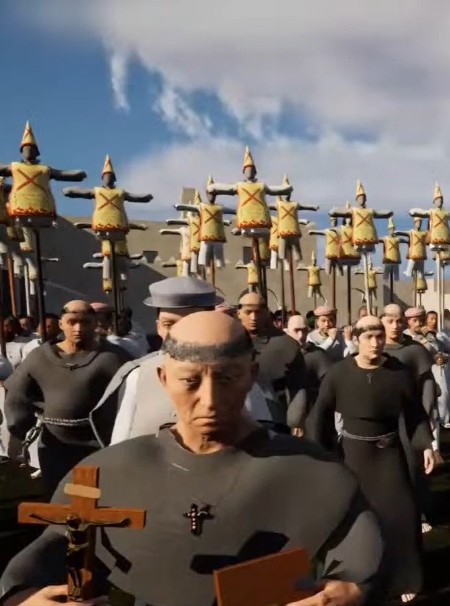
Virtual recreation of Mani's auto de fe, (Museo Regional de Antropología de Mérida, Palacio Cantón, 2024)
Letter of Diego Rodríguez Bibanco.
By royal appointment Defender of the Indians of Yucatan, To the King, March 8, 1563.
"[...] What happens is that the friars of the order of San Francisco in this province used the ecclesiastical jurisdiction before the bishop's arrival, saying they had the power by apostolic bulls to do this in places where there are no bishops; and in this title, good or bad, using the said Bulls, which it is understood did not give them the right to do what they have done, they gave orders to proceed against the Indians of all these provinces, generally, por via de inquisición, the Provincial [Diego de Landa] constituting himself Inquisitor, and accompanied by the subordinate friars who also served as inquisitors; and together or singly they have inflicted irregularities and punishments on these Indians never heard of in all the Indies, under color of and saying that they were idolaters.
" [...] And so, with the power they claimed as ecclesiastical judges, and that which your Justice gave them, they set about the business with great rigor and atrocity, putting the Indians to great tortures, of ropes and water, hanging them by pulleys with stones of 50 or 75 pounds to their feet, and so suspended gave them mans, lashes until the blood ran to the ground from their shoulders and legs; besides this they tarred them with boiling fat as was the custom to do to negro slaves, with the melted wax of lit candles dropped on their bare parts; all this without preceding information, or seeking first for the facts. This seemed to them the way to learn them.
" The poor Indians, weak and miserable, afflicted and maltreated, in fear of the torture, while under the torture confessed irregularities they have neither committed nor thought of, saying they were idolaters, and had quantities of idols, and had even sacrificed human beings and done other great cruelties; all being false and stated in fear and for the pain they suffered.
" Thus they brought in a great quantity of idols they had had in ancient buildings and the woods and caves, already left and forgotten, and said that they now had and used them; on which confessions, without listening to the Indians or their Defender, or making any verification beyond what came by the tortures, they sheared them, beat and punished them, usually every one in the pueblos they visited. Some individuals, leading caciques and persons, they condemned to ten years slavery, more or less; put or them the penitential sambenito garments of the Inquisition, banished them from their signories and towns, and made them slaves, and so treated them. From all they also exacted fines of two, three or more ducats, and from the common people two or four reales, by which they collected great sums of money; and in this way they did with most of the Indians where the Inquisition and punishment were instituted. They made two Autos of Inquisition, erecting high tablets and banners with insignia, such as your majesty's inquisitors use, putting great numbers of Indians in the province in the corozas [shame headdresses] and sambenitos, and declared it was necessary in the case.
" From all which, and much more I cannot tell your majesty for the prolixity, great harm to the Indians resulted; for seeing the things, they fled many to the forests, others hung themselves in despair, many others were left wounded, without hands or feet, and many others died of the tortures inflicted. Thus the whole country was afflicted, aroused, oppressed and maltreated, until last August the bishop, don fray Francisco de Toral arrived, named by your majesty as prelate and pastor for this province; who took on himself the matter and the state of things he found, and before whom I, in the name of the Indians, asked relief. […]
" That your majesty may be advised, I ask the royal secretary of the council of this city to attach the certificate that I am such Defender of the Indians. Sacred Catholic royal majesty, I kiss your royal feet.
Your humble vassal,
DIEGO RODRIGUEZ BIBANCO.

A popular representation of the auto-da-fé in Maní
The crown, through a royal accord with the Audiencia of Mexico, sent Landa a stern rebuke in November 1577, warning him not to continue in his policy of naming regular clergyman as ecclesiastical judges. The crown reprehended Landa:
“It has come to our attention that You, the said Bishop of Yucatán, have given and continue to give many commissions to the religious friars of the order of Saint Francis residing in the monasteries of that province, so that they can proceed against the Indians of their towns and conduct trials for certain acts of idolatry that they have done since their infidelity. [...]
With these commissions and trials, they [the friars] bothered, tormented, and tortured the natives, imposing many very cruel and excessive punishments, forcing them to pay pecuniary fines, and seizing their goods and belongings, heaping upon them many other abuses and vexations which are all prohibited by our Royal Cedulas. [...]
In order to remedy these abuses, we order that from here on wards you should not give these commissions, nor any others to the said religious friars, nor should you consent that they use them, not even those which you have already given [...] and we order you to revoke all of these said commissions and remove the commissary judges [...] and in other similar cases that touch upon your ecclesiastical jurisdiction, you and your secular judges should proceed against the Indians with all consideration of their limited capacity.“
(Cedula real sobre que el Obispo de Yucatán no excede en su castigo y reprehensión de los indios idolatras y que no le permite dar comisiones de jueces de idolatrias a los frailes del orden de San Francisco,” 1577, AGI, Audiencia de Mexico, 364, 4 folios.)
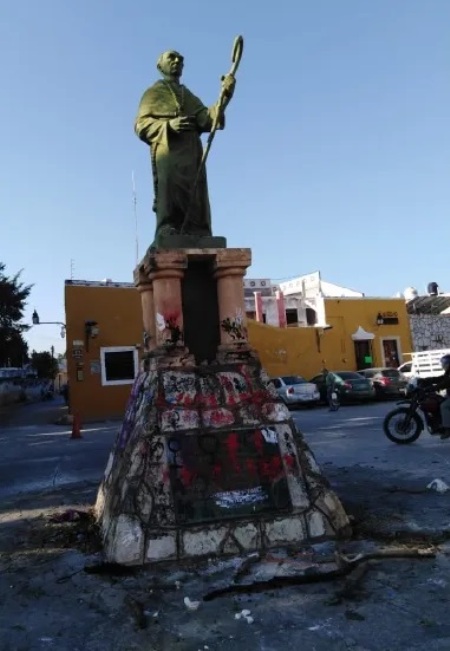
Izamal, 2023, March, Friar Diego de Landa' statue burned by a group of students
Diego de Landa:
"After the people had been thus instructed in religion, and the youths benefited as we have said, they were perverted by their priests and chiefs to return to their idolatry; this they did, making sacrifices not only by incense, but also of human blood. Upon this the friars held an Inquisition, calling upon the Alcalde Mayor for aid; they held trials and celebrated an Auto, putting many on scaffolds, capped, shorn and beaten, and some in the penitential robes for a time. Some of the Indians out of grief, and deluded by the devil, hung themselves; but generally they all showed much repentance and readiness to be good Christians."
(Diego de Landa, Relación de las cosas de Yucatán, Sec. 18. Vices of the Indians. Studies of the friars in the language of the country. Their teachings to the Indians. Conversions. Punishments of apostates).

Lope de Vega, El Nuevo Mundo descubierto por Cristóbal Colón, Instituto de Cultura Hispánica, Madrid, 1963
An Indian speaking, in Lope de Vega, The Discovery of the New World by Christopher Columbus (El Nuevo Mundo descubierto por Cristóbal Colón), circa 1600
Dulcán:
"What shall I do? Shall I leave my Ongol
For this foreign Christ,
God-Man and Spanish God?
Should I leave the moon and light,
Night, day, sky, sun?
There is nothing more impossible
Than leaving your old faith
And your terrible customs.
But if Ongol was an angel,
And Christ is invincible;
That mean and impatient
Maker who perished
For being impudent and rebellious,
Following Christ is better."
(III. 2706-2729)
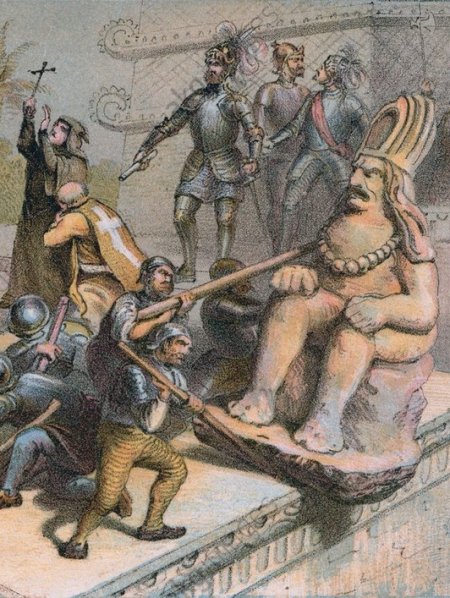
The destruction of the idols, August C. Haun, 1866
Fray Jerónimo de Mendieta:
"Although on the one hand these servants of God were heartily content at seeing how the people attended their sermons and listened to their doctrine, on the other hand they suspected that the Indians might be attending church merely to comply superficially with the orders given them by their nobles in order to deceive the friars, and that this might not be a sincere movement by the people to seek the remedy for their souls by renouncing the worship of the idols. And the friars persuaded themselves that this was indeed the case, for they were told that, while in public the Indians no longer made their old sacrifices, which usually involved the killing of men, in the secret spaces of the hills and in fearful, remote places, and at night in the temples of the demons which were still standing, they continued to make their sacrifices, and in the temples they performed their old ceremonies, chants, and drunken celebrations. [...]
"Business went on as usual, and the idolatry continued so the friars agreed to begin destroying the temples, and not to stop until they were all burned to the ground, and the idols likewise destroyed and eradicated, even though in doing this they would place themselves in mortal danger. They carried out their plan, [...] taking with them the children and young men they had raised and instructed, the sons of the Indian lords and nobles, and they also received help from the common people who were already converted and wanted to prove that they were confirmed in the faith."
(Fray Jerónimo de Mendieta, Historia eclesiástica indiana, Libro tercero, Capítulo XX, Cómo los religiosos, con ayuda de sus discípulos derrotaron los templos de los ídolos)

Looting of Maya sites today: United States returns to Mexico a fragment of Stela 2 from the Mayan site La Mar, in Chiapas -April 2019-
Vatican News, 2023, March 30
“
The Popes have condemned acts of violence, oppression, social injustice, and slavery, including those committed against indigenous peoples. [...] The Church has acquired a greater awareness of their sufferings, past and present, due to the expropriation of their lands … as well as the policies of forced assimilation, promoted by the governmental authorities of the time, intended to eliminate their indigenous cultures,”
“Historical research clearly demonstrates that the papal documents in question, specifically two bulls of Nicholas V, Dum diversas (1452) and Romanus Pontifex (1455); and Alexander VI’s bull Inter caetera (1493), written in a specific historical period and linked to political questions, have never been considered expressions of the Catholic faith, The Church acknowledges that these papal bulls did not adequately reflect the equal dignity and rights of indigenous peoples.[...] The contents of these documents were manipulated for political purposes by competing colonial powers in order to justify immoral acts against indigenous peoples that were carried out, at times, without opposition from ecclesiastical authorities.[..] It is only just to recognize these errors, acknowledge the terrible effects of the assimilation policies and the pain experienced by indigenous peoples, and ask for pardon.”

Standing in front of the Comalcalco Mayan ruins, Tabasco, Mexico President Andrés Manuel López Obrador, alongside his wife, has hasked King Pelipe IV of Spain and Pope Francis to apologize to his country for the conquest of the Americas five century ago
2025 "Friars and Mayas"
|

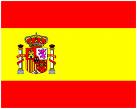
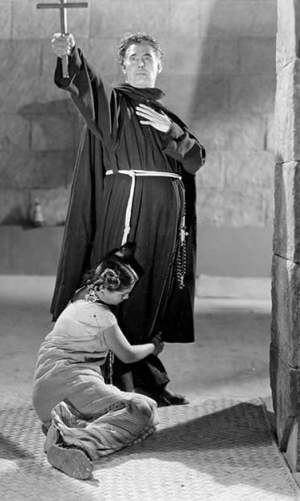
A conversion in the Mexican movie by Julio Bracho, "La Virgen que forjó una patria", 1942.
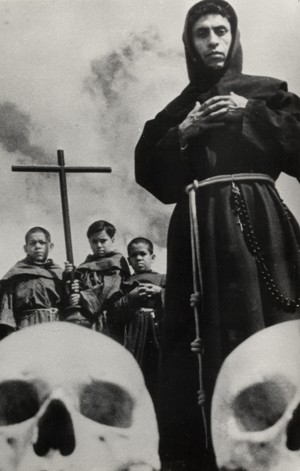
The black legend, the Franciscans as seen by Eisenstein, in his movie Qué Viva México, 1930
Juan Focher, Itinerarium Catholicum Profiscentium ad Infideles Convertendos, Catholic Itinerary for Those Who Set Out to Convert the Infidels, 1574
"Christ the Lord, upon sending the Apostles to preach, established a double form of living. First, when he said to them in Matthew 10 : « Do not take gold, or silver, or money in your belts, or a bag for your journey, or two tunics, or shoes, or a staff. » For this form was observed by them in times of peace : that is, when both on their journeys and in the villages where they went to preach, they provided them with food and the rest of the things necessary for life. But he also set before them a second norm, saying in Luke 22 : « But now, the one who has a purse must take it, and likewise a bag. And the one who does not have » - understand a sword - « must sell his tunic and buy a sword. » For that form of life, instead, almost contrary to the other, was legitimaly observed by the Apostles in times of persecution : that is, when both on the journey and in the villages where they went to preach they probably would not find someone to supply the necessities of life. For Christ, not wanting the promulgation of the Gospel to fail on account of the observation of the first norm, allowed them to carry on their journeys not only the necessary food, but also even to use a moderate self-defense, when otherwise they would not able to advance and preach. He shows through this that a lesser good should not impede a greater good."
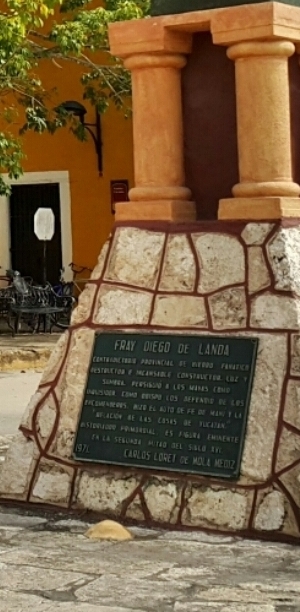
Iron slab set below the statue of Fray Diego de Landa, at Izamal
"Contradictory provincial, with seemingly iron views. A fanatic destroyer and tireless builder. Light and shadow. He pursued the Maya as an inquisitor. As bishop he defended them from the encomenderos. He burned Maya relics and writings in the auto-da-fé at Maní and then wrote the chronicle of Maya history, "An Account of the Things of Yucatan". A primordial historian, he is an eminent figure in the second half of the sixteenth century. 1971. Carlos Loret de Mola Mediz." [Yucatan governor, 1970-1976]
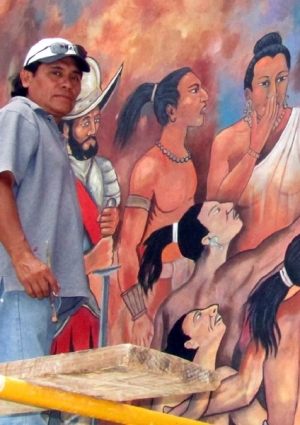
Oxkutzcab, Yucatán, 2017, april 16, the artist Leonardo Paz Novelo restores his mural "Auto de fe de Maní", first painted in 1998
